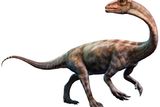Science
Ancient Dinosaur Fossil Discovered in Argentina’s La Rioja Region

A significant paleontological discovery has emerged from the foothills of the Andes in Argentina, where researchers have unearthed one of the world’s oldest dinosaurs. The nearly complete fossil, estimated to be around 230 million years old, belongs to a new species called Huayracursor jaguensis. This finding, detailed in a study published in the journal Nature, sheds light on the evolutionary history of early dinosaurs during the Late Triassic period.
The fossil was found in the La Rioja province, a region that has recently garnered attention for its wealth of Triassic-era discoveries. The near-complete skeleton included significant parts such as the skull, vertebral column, forelimbs, and hindlimbs. According to Martín Hechenleitner, a researcher at the National Scientific and Technical Research Council of Argentina (CONICET), “It’s one of those discoveries that don’t come along often.” Fellow researcher Agustín Martinelli highlighted the age of the specimen, noting, “We estimate that Huayracursor must have been between 230 and 225 million years old, making it one of the oldest dinosaurs in the world.”
Insights into Early Sauropodomorphs
The newly identified Huayracursor is classified as an early sauropodomorph, a group of long-necked, herbivorous dinosaurs. Measuring approximately 2 meters (about 6 feet) in length and weighing around 40 pounds, this species was larger than many of its contemporaries, such as the Bagualasaurs. Hechenleitner emphasized the evolutionary importance of this discovery, stating, “Huayracursor is novel because it exhibits two key features: a considerably longer neck and a larger size than most of its contemporaries. These aspects confirm a very early and synchronous appearance of both characteristics.”
The discovery is particularly noteworthy given the challenging terrain in which the fossil was located. The research team, which was among the first to explore this remote area of La Rioja, faced significant obstacles due to the region’s weather and landscape. Their perseverance paid off, as they have uncovered a wealth of Triassic fauna in the past decade. Martinelli remarked, “This new region, within a virtually unexplored geological basin, opens up the prospect of major discoveries.”
Future Explorations in La Rioja
The implications of discovering one of the oldest dinosaurs extend beyond the fossil itself. The completeness of the Huayracursor specimen offers a unique opportunity to further understand early sauropodomorph evolution. The research team plans to expand their explorations, with an eye towards uncovering more fossils in the surrounding areas of the Andes. Sebastián Rocher, an author of the study, explained, “Based on stratigraphic and sedimentological studies, we recognized that the Triassic terrains of the Northern Precordillera belong to a sedimentary basin that evolved independently of other basins in southwestern Gondwana.”
The name Huayracursor reflects the region’s unique characteristics, with “Huayra” referring to the area’s high winds and “jaguensis” acknowledging the nearby village of Jagüé. As interest in this region grows, the potential for further significant discoveries remains high, promising to add depth to our understanding of prehistoric life.
This remarkable find underscores the ongoing importance of field research in paleontology and the ever-evolving narrative of dinosaur evolution. As researchers continue to explore the rich geological history of La Rioja, new insights into the lives of ancient creatures are sure to emerge.
-

 Business1 week ago
Business1 week agoIconic Sand Dollar Social Club Listed for $3 Million in Folly Beach
-

 Politics1 week ago
Politics1 week agoAfghan Refugee Detained by ICE After Asylum Hearing in New York
-

 Health1 week ago
Health1 week agoPeptilogics Secures $78 Million to Combat Prosthetic Joint Infections
-

 Science1 week ago
Science1 week agoResearchers Achieve Fastest Genome Sequencing in Under Four Hours
-

 Health1 week ago
Health1 week agoResearcher Uncovers Zika Virus Pathway to Placenta Using Nanotubes
-

 Lifestyle1 week ago
Lifestyle1 week agoJump for Good: San Clemente Pier Fundraiser Allows Legal Leaps
-

 World1 week ago
World1 week agoUS Passport Ranks Drop Out of Top 10 for First Time Ever
-

 Entertainment1 week ago
Entertainment1 week agoJennifer Lopez Addresses A-Rod Split in Candid Interview
-

 Business1 week ago
Business1 week agoSan Jose High-Rise Faces Foreclosure Over $182.5 Million Loan
-

 Top Stories6 days ago
Top Stories6 days agoChicago Symphony Orchestra Dazzles with Berlioz Under Mäkelä
-

 World1 week ago
World1 week agoRegional Pilots’ Salaries Surge to Six Figures in 2025
-

 Science1 week ago
Science1 week agoMars Observed: Detailed Imaging Reveals Dust Avalanche Dynamics









